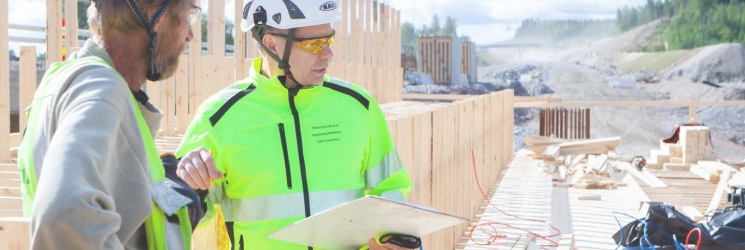

Safety and health in the workplace
Identifying hazards
Identifying and assessing hazards is the basis for occupational safety and health at the workplace. According to the Occupational Safety and Health Act, the employer must consistently investigate the risks to the health and safety of employees.
The risk assessment shall be:
- Verifiable. In practice, a written or online assessment method shall normally be used. Where there is an obvious health risk within the task or industry (e.g. chemical, biological and physical hazards and the threat of violence), the regulations always require a written risk assessment.
- Up-to-date.
It is a good idea to plan the risk assessment carefully, because then it will be easier and quicker to implement. If the employer does not possess adequate expertise for the assessment, they shall be assisted by qualified experts. One expert is occupational healthcare that can perform a workplace survey to assess the effects of the risks to employees' health.
The assessment technique must be chosen taking the number of employees and the nature of the work into account
The employer can choose the best risk assessment method for their workplace. For example, The Centre for Occupational Safety online service (in Finnish) offers forms for this purpose. It should be noted that the forms have been created to suit different industries and workplaces of different sizes. That is why almost every job includes hazards that are not mentioned on the form, and on the other hand, some points are unnecessary for various jobs.
The risk assessment method shall be sufficiently comprehensive in relation to the employer's sector, the nature of the activities and the size of the workplace. The assessment shall take into account the specific characteristics of the work, such as working alone and demanding conditions. Some jobs have their own regulations that must be complied with (e.g. construction work and handling hazardous chemicals).
When investigating hazards, the employer shall consider all risks related to working and the working environment.
The assessment shall focus on all workplace tasks, including:
- maintenance, downtime and other similar special situations
- exceptions and incidents
- peaks and high seasons
- holidays and the use of substitutes and trainees
- work outside the workplace (including abroad)
- work carried out at the workplace by self-employed people and employees form other companies (e.g. suppliers, cleaners, maintenance and repair personnel), i.e. so-called work at a common workplace; workplace conditions must not pose a danger to these employees either.
Risk assessment is carried out from many points of view
The risk assessment shall take into account occupational safety and health management procedures, i.e. guidelines and practices. For example, if there is an obvious risk of violence at work, the employer must have an operating model for the threat of violence. The risk assessment will also examine how management procedures are working in practice. If a workplace has instructions for psychosocial strain, for example, but there are many sick leaves caused by strain, it is necessary to evaluate the management procedures and to make corrections to them.
The risk assessment process utilizes the occupational healthcare survey and information about sick leaves, occupational diseases, accidents and incidents. In order for the employer to analyse the above information, there must be a working procedure for collecting information at the workplace. The assessment will also ensure that health checks are carried out on those working under a particular risk of illness.
The risk assessment shall take into account, in general terms, the personal conditions of employees (e.g. size, age-related changes, work experience and professional skills). For example, an employee’s size may affect whether a tool is safe or the worktop ergonomically at the right height. The assessment shall also take into account the needs of specific groups (e.g. young employees, pregnant employees and people with partial work capacity).
The risk assessment shall also examine the following workplace practices and their effectiveness. More detailed descriptions can be found in the Workplace risk assessment workbook (in Finnish). More information on early support for working capacity can be found on the online service of the Finnish Institute of Occupational Health (in Finnish).
- Occupational safety and health action programme
- Cooperation in occupational safety and health
- Orientation and work guidance
- Activities at the common workplace
- Abnormal situations and disturbances
- Personal protective equipment
- Use of protective equipment and tools
- Addressing unsafe activities and risk-taking
- Substance abuse program
- Fire work permits and working with fire
- Alarms and rescue equipment
- Fire extinguishing equipment and their markings
- Walkways and corridors and their safety and indicator lights
- Emergency exits and their markings
- First aid arrangements and equipment
- Staff readiness in an emergency
- Early support methods for working capacity.
Once the issues related to occupational safety practices have been identified, the collective risks will be assessed. They are presented under the headline Typical hazards.
This website is part of the European Commission's Your Europe portal. Did you find what you were looking for?


